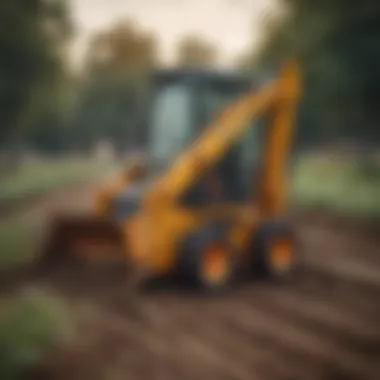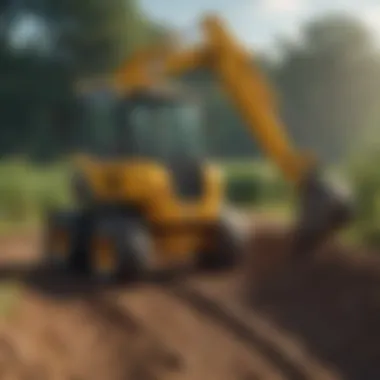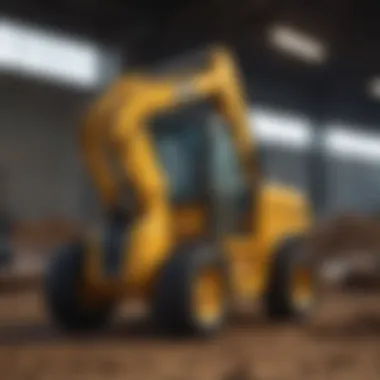Understanding Mini Trackhoes: An In-Depth Analysis


Intro
Mini trackhoes have become essential equipment in the agricultural sector, revolutionizing how certain tasks are performed. As farms grow larger and the demand for efficiency increases, the importance of mini trackhoes cannot be underestimated. But what exactly are these machines, and how do they fit into modern agricultural practices? This article will explore the specifications, advantages, and applications of mini trackhoes, along with maintenance considerations and market trends shaping their use.
Topic Overview
To fully understand mini trackhoes, it's vital to grasp key terminology. A mini trackhoe, also known as a mini excavator, is a compact, versatile machine designed for various digging and earth-moving applications. Its smaller size allows it to operate in tighter spaces compared to traditional excavators. This not only maximizes efficiency but also minimizes disruption in agricultural settings.
Definition of Key Terms
- Mini Trackhoe: A smaller version of an excavator that can navigate tight spaces while performing excavation tasks.
- Hydraulic System: A system that uses pressurized fluid to operate machinery. It is fundamental in mini trackhoes for moving the boom, bucket, and other components effectively.
- Digging Depth: This refers to how deep a mini trackhoe can dig, a crucial aspect for tasks such as drainage installation or planting.
Relevance in Agriculture, Horticulture, and Agronomy
Mini trackhoes are particularly relevant in diverse agricultural fields. In horticulture, they assist with soil preparation and planting. For agronomy, their ability to efficiently handle tasks like land clearing and trenching makes them invaluable. Overall, they enhance productivity and allow farmers to manage their operations with greater ease.
Current Trends and Innovations
As technology advances, so does the design and functionality of mini trackhoes. Recent trends emphasize efficiency, ease of use, and safety, reshaping their operational capabilities.
Recent Advancements in the Field
Mini trackhoes now feature integrated cab systems that improve the operator's experience. With better visibility and control interfaces, these machines enable precise movements, reducing the risk of accidents. Innovations like fuel-efficient engines also contribute to sustainability in farming practices.
Emerging Technologies and Practices
Technological advancements include the use of telematics in mini trackhoes. This system allows operators to monitor machine performance and location in real-time. Understanding these metrics can lead to better maintenance and operational efficiency, ensuring that machines remain in optimal working condition.
Practical Applications
The practicality of mini trackhoes extends far across agricultural tasks. Their versatility caters to various needs in farming.
Step-by-Step Guides or How-Tos
- Site Preparation: Start by clearing the area of obstacles. Then, use the mini trackhoe to level the ground for planting or construction work.
- Trenching: Position the trackhoe above the designated trench line. Carefully lower the bucket to the required depth, ensuring to check for underground utilities before proceeding.
- Soil Excavation: Use smooth, controlled movements to excavate soil, avoiding sudden jerks that can damage the machine or the earth.
Tips and Best Practices for Implementation
- Regularly check the hydraulic fluid levels. Low fluid can cause the hydraulic system to fail.
- Conduct daily inspections to spot wear and tear early, thus preventing bigger issues.
- Train operators adequately to ensure safety and efficiency when using mini trackhoes.
"Investing in properly maintained mini trackhoes can significantly enhance productivity on the farm. Regular upkeep is essential for longevity and optimal performance."
Intro to Mini Trackhoes
Mini trackhoes play a crucial role in modern agriculture, offering tailored solutions for various tasks. Their compact design allows them to operate efficiently even in confined spaces. Many farmers and contractors consider them essential equipment because they increase productivity while minimizing soil disruption.
The purpose of this section is to explore what mini trackhoes are and their significance in agricultural practices. Understanding their definition and historical context will provide insight into how they have evolved and adapted to meet growing demands.


Definition and Purpose
Mini trackhoes are essentially smaller versions of standard excavators. They are designed for tasks requiring precision and finesse, such as digging, grading, and landscaping. Unlike larger machines, mini trackhoes can maneuver easily in tighter areas, making them ideal for residential and agricultural projects where space is limited. Their versatility allows them to be used across various applications, from site excavations to road constructions.
The primary purpose of mini trackhoes is to enhance efficiency in tasks that involve earth removal. Given the advancements in hydraulic technology, these machines can easily lift heavier loads relative to their size. That translates to faster completion of projects and a reduction in labor costs.
Historical Context
The evolution of mini trackhoes mirrors the advancements in construction and agricultural machinery. Originally, heavy machines dominated land-moving tasks, which often resulted in more soil compaction and damage to the surroundings. As the industry recognized these issues, there was a shift toward more compact machinery.
Mini trackhoes emerged in the late 20th century as a response to the need for equipment that could operate in constrained areas. As technology improved, it allowed for the reduction of size without sacrificing power. This led to the development of more robust engines and hydraulic systems that could handle demanding tasks. The historical context is essential as it shows how these machines have adapted to serve the needs of modern agriculture and construction even more efficiently.
Technical Specifications
Technical specifications are crucial for understanding the capabilities and limitations of mini trackhoes. They offer essential insights into how well a machine can perform its designated tasks, especially in the diverse field of agriculture. When selecting a mini trackhoe, knowing the specifications helps professionals evaluate suitable options for their specific agricultural needs.
Size and Dimensions
The size and dimensions of mini trackhoes play a significant role in their usability. A smaller machine can easily navigate tight spaces on farms, making it ideal for landscaping or working around existing crops. The width and height of a mini trackhoe impact how it fits into various environments.
Moreover, the reach and digging depth capabilities are important. For instance, a standard mini trackhoe can have a digging depth of around 7 to 9 feet. This depth is often sufficient for most agricultural tasks like planting, trenching, or building irrigation systems. Nevertheless, the specific requirements of the site should determine the ideal size and dimensions for optimal performance.
Engine and Power Output
The engine and power output dictate how effectively a mini trackhoe can perform its tasks. Most mini trackhoes are equipped with diesel engines that provide ample power while maintaining fuel efficiency. The horsepower can range from 20 to 50 horsepower, depending on the model. A more powerful engine enables heavier lifting, faster digging, and overall enhanced functionality.
In agricultural settings, the power output directly influences productivity. A strong engine facilitates quicker job completion, allowing farmers to invest more time in other essential activities. However, it's also important to balance power with fuel efficiency, as excessive fuel consumption can lead to higher operational costs over time.
Operating Weight
Operating weight is another critical aspect that impacts the performance and stability of a mini trackhoe. It generally varies from approximately 2,500 to 10,000 pounds. Lighter machines can be more maneuverable, but they may struggle with stability when working on uneven terrain. Conversely, heavier models offer greater stability and can handle larger attachments or heavier loads.
The choice of operating weight must consider the soil and conditions in which the machine will operate. For instance, working on softer, loamy soils might require a lighter model to avoid sinking, whereas compacted soils would benefit from a heavier unit. Keeping an eye on the specific needs of the agricultural tasks can lead to better decision-making when choosing the right mini trackhoe.
"Knowing the technical specifications of mini trackhoes is essential for farmers to make educated decisions that impact productivity and efficiency in their operations."
Applications in Agriculture
Mini trackhoes have gained significant traction in agricultural practices due to their remarkable adaptability and efficiency. Their compact size allows them to operate in tight spaces where larger machinery often cannot, making them an invaluable asset for farmers and land management professionals. Understanding various applications of these machines can aid agricultural enthusiasts in optimizing their operations while tackling specific land challenges.
Site Preparation
Preparing a site for planting or construction is crucial in agriculture. Mini trackhoes excel in this area because they can quickly clear land of debris, roots, or unwanted vegetation. Their articulated arm allows for precision digging, which is essential when creating planting beds or leveling ground.
- Efficiency: These machines can accomplish in a few hours tasks that might take days using manual labor.
- Accessibility: They can navigate through narrow pathways between crops, reducing the risk of damaging existing plants.
- Customization: Different attachments, such as buckets or grading blades, can be used for specific site preparation needs, enhancing their versatility.
Irrigation Management


Efficient irrigation management is vital for crop health and yield. Mini trackhoes play a significant role in installing and maintaining irrigation systems.
- Ditch Creation: They can dig trenches for piping easily, ensuring proper water flow and management across varied terrains.
- Drainage Solutions: With the ability to excavate and shape land, they can facilitate drainage systems that prevent waterlogging, consequently protecting crops.
- Installation Flexibility: They allow for the adjustment of existing irrigation systems by enabling easy modifications to the layout when crop rotation or changes in land usage require it.
Soil Excavation and Landscaping
Excavating soil is a common activity in agriculture when preparing for new crops or changing the landscape. Mini trackhoes provide precision and power.
- Soil Quality Improvement: By allowing deep excavation, these machines can help in better aeration and soil mixing, which can improve plant growth.
- Landscaping Needs: They are useful for creating terraces or enhancing soil profiles as per specific agricultural requirements.
- Cost-Effective: By minimizing the need for multiple machines, mini trackhoes can reduce operational costs significantly while providing the essential services needed for effective landscaping.
Utilizing mini trackhoes can transform agricultural operations, leading to increased productivity and efficiency in site preparation, irrigation management, and soil excavation.
Advantages of Mini Trackhoes
The significance of understanding the advantages of mini trackhoes is pivotal for professionals in the agricultural sector. Such machinery can considerably enhance efficiency and productivity on farms. Mini trackhoes offer several specific benefits that make them a preferred choice over traditional, larger excavators. They enable farmers to perform tasks that require precision and power while minimizing the impact on the working environment.
Compact Size and Maneuverability
Mini trackhoes are designed with a compact structure, which allows for easy maneuverability in tight spaces. Their smaller frame enables operators to navigate around obstacles and work in confined areas where larger machines cannot operate. This is particularly important in agriculture, where the landscape can vary significantly. For example, when working in orchards or vineyards, the ability to quickly change direction or access small plots of land proves invaluable.
The compactness of mini trackhoes means they can work effectively in almost any agricultural setup, increasing overall operational flexibility.
Additionally, the lighter weight contributes to ease of transport. Farmers can trailer mini trackhoes to different locations, saving both time and effort when moving from one job site to another. This advantage is amplified when using public roads or smaller paths leading to rural areas.
Fuel Efficiency
Another critical advantage lies in fuel efficiency. Mini trackhoes typically consume less fuel than larger counterparts. This efficiency is not only cost-effective for day-to-day operations but also reduces the overall carbon footprint of agricultural activities. Given the rising concerns about sustainability and environmental impact, using machines that require less fuel aligns with current ecological practices.
Farmers focused on maintaining lower operational costs will find that the fuel savings add up over time, allowing for a more profitable bottom line. For instance, many operators report substantial savings on fuel costs, which can be reinvested into other areas of the business. Moreover, the decreased reliance on fuel contributes positively to the environmental footprint of agricultural practices.
Versatility Across Terrain
Mini trackhoes are exceptionally versatile when it comes to handling various terrains. They can work effectively on soft soils, rocky landscapes, and on inclines. This adaptability is particularly useful in agricultural settings, where conditions can change dramatically based on the season or specific crop needs. For instance, a farmer might have to excavate some soil for planting in drainage areas and then seamlessly transition to compacting soil in other parts of the field.
Their ability to perform various tasks like digging, trenching, and land grading makes mini trackhoes a multipurpose tool. With the right attachments, these machines can engage in a wide range of operations, further demonstrating their utility in diverse farming activities.
Market Trends
Market trends play a crucial role in the agricultural sector, particularly concerning mini trackhoes. As the needs of farming evolve, so do the technologies and practices that drive efficiency and productivity. Understanding these trends allows farmers and industry professionals to stay ahead of the curve.
Emerging technologies, such as automation and precision farming, are changing how mini trackhoes are utilized in agricultural operations. With advancements in technology come improvements in these machines that not only enhance their capabilities but also broaden their applications. The integration of GPS mapping and telematics systems can provide real-time data to operators, streamlining decision-making processes on-site.
Moreover, sustainability practices are becoming increasingly important in agriculture. As environmental concerns grow, there is a need for equipment like mini trackhoes that align with sustainable practices. This includes the use of low-emission engines and designs that minimize soil disturbance. Farmers are now more inclined to invest in equipment that not only meets their operational needs but also adheres to eco-friendly standards. Such equipment becomes vital not only for compliance but also for public perception and marketability.
It is also important to consider the cost implications that these trends bring. While newer technologies and sustainable practices can involve higher initial investments, the long-term savings on fuel, maintenance, and potential regulatory compliance can be significant. Evaluating these factors can aid in making informed purchasing decisions.
"Investing in the latest equipment driven by market trends is not just about staying competitive; it’s about creating a more sustainable future alongside farming success."


Overall, staying informed on market trends is not merely advantageous; it is essential for any serious player in the agricultural field.
Emerging Technologies
Emerging technologies are reshaping the landscape of agricultural equipment, including mini trackhoes. These technologies not only improve the efficiency of operations but also enhance precision in tasks. Tools equipped with robotic capabilities are taking mini trackhoes to the next level. Automation allows for repetitive tasks to be performed with higher accuracy and less labor, which can lead to significant cost savings and increased productivity. Furthermore, data analytics behind these technologies facilitates better planning and resource allocation.
Some notable technologies include:
- Telematics: This enables users to monitor equipment performance remotely. It provides insights into fuel usage, maintenance schedules, and operational efficiency.
- Artificial Intelligence: Implementing AI can optimize excavation processes by predicting soil conditions and suggesting the best equipment settings.
The rapid integration of these technologies shows how farming practices are becoming more data-driven, enabling farmers to make better decisions. When mini trackhoes incorporate these technological advancements, they not only fulfill traditional roles but also transform agricultural practices into a sophisticated operation.
Sustainability Practices
Sustainability practices in agriculture are now pivotal. The farming industry faces increasing pressure to reduce its environmental footprint. Mini trackhoes contribute positively by incorporating sustainable designs and practices.
Some specific sustainability-focused aspects to consider include:
- Low Emission engines: These are designed to comply with environmental regulations, reducing pollution and operating costs.
- Minimization of Soil Disturbance: Advanced designs allow for more precise digging and excavation, preserving soil structure and health.
- Energy-efficient Operations: Many manufacturers now focus on producing equipment that uses less fuel without sacrificing performance.
Emphasizing these sustainability practices not only aids in compliance with regulations but can also enhance a farm’s reputation. The public is increasingly aware of agricultural practices, and showcasing a commitment to sustainability can attract consumer support.
Challenges and Considerations
Understanding the challenges and considerations of mini trackhoes is essential for those in the agricultural sector who are looking to incorporate these machines into their operations. While mini trackhoes offer numerous advantages, they also present specific demands that must be addressed to optimize their functionality and ensure operational efficiency.
Maintenance Needs
Regular maintenance is critical to the longevity and performance of mini trackhoes. Owners need to establish an effective maintenance schedule that includes routine checks on hydraulic systems, tracks, and engines. It is advisable to clean the undercarriage after use to prevent dirt accumulation and subsequent wear.
Additionally, monitoring oil levels and replacing filters at specified intervals can prevent engine problems. Neglecting these tasks could lead to costly repairs and downtime, which ultimately impacts productivity. Engaging a qualified technician for periodic inspections can enhance machine reliability and help identify potential issues before they escalate.
Operator Training Requirements
Another vital consideration involves the training of operators. Mini trackhoes, despite their compact size, require proficient handling to maximize safety and efficiency. Training programs should cover basic operation, safety protocols, and maintenance procedures.
Inadequate training can lead to accidents, reduced productivity, and excessive wear on machinery. Therefore, it is in the best interest of employers to invest in comprehensive training for their operators. Some companies offer certifications, which can further ensure that operators are well-equipped to handle the machinery responsibly.
Cost Implications
Cost is always a consideration when integrating new equipment into agricultural practices. The initial investment for a mini trackhoe can be substantial, but potential long-term savings should be factored in. Operating a mini trackhoe may reduce the need for additional labor and improve project turnaround time.
However, it is crucial for farmers to assess ongoing costs, including maintenance, fuel, and insurance. Additionally, unforeseen repairs can arise, which should be budgeted for in order to maintain a fluid operational structure. Detailed financial planning becomes imperative when considering the purchase or lease of trackhoes.
Ending
The conclusion serves as a critical lens through which one can reflect on the comprehensive nature of mini trackhoes. In this article, we have delved into the technical specifications, applications, benefits, market trends, and challenges of mini trackhoes in agriculture. Each section highlighted different aspects that are indispensable for professionals in the agri-sector, ensuring a holistic understanding of these versatile machines.
Understanding the future outlook on mini trackhoes is particularly vital. As agriculture continues to evolve with technological advancements, the integration of mini trackhoes will play a significant role in increasing efficiency and productivity. Their compact size is not just a superficial detail; it allows for usability in tighter spaces, which is increasingly common in modern farming environments.
Moreover, recognizing the maintenance needs discussed in the challenges section minimizes operational disruptions. Proper upkeep not only extends the equipment's lifespan but also ensures that it performs optimally, which is critical for any agricultural operation.
Investing in operator training also stands out as a key takeaway. Skilled operators not only enhance safety but also maximize the benefits derived from using mini trackhoes. Understanding how to manipulate these machines effectively can lead to significant improvements in site preparation, soil excavation, and other vital agricultural tasks.
In summary, the article encapsulated the various layers of knowledge required to make informed decisions regarding mini trackhoes. By appreciating the strengths and challenges associated with these machines, agricultural professionals can optimize their operations and adapt to the ever-changing demands of the industry. As we look ahead, the importance of mini trackhoes will only grow, signaling a pivotal shift in how agricultural tasks are approached.



